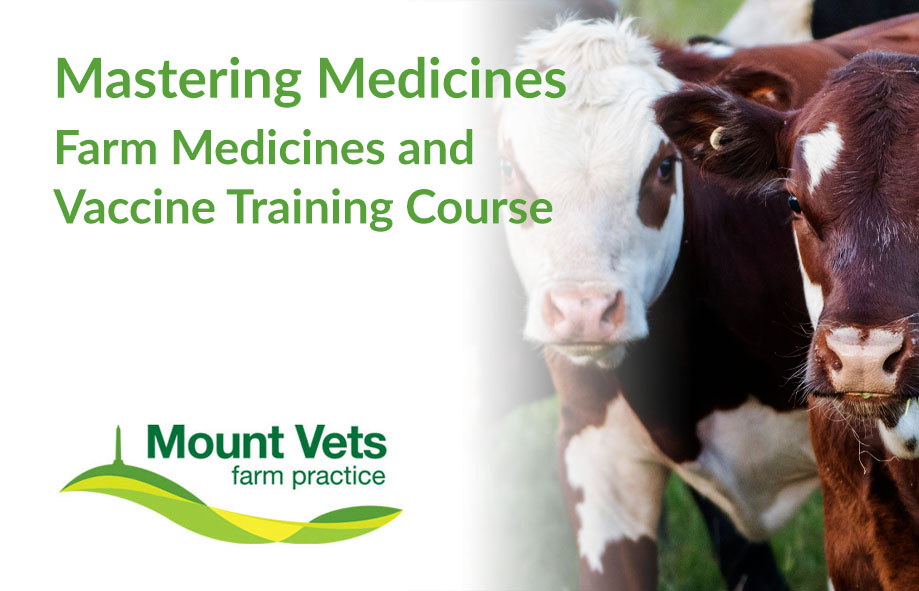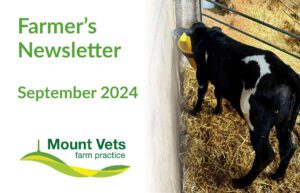May 2023
Here is the latest from our farm team at Mount Vets. If you would like any further advice or would like us to cover something in the next newsletter, please call us on 01823 662286 or contact us here.
We want to hear your feedback… Leave us a review!
Our new website is now live. We hope you enjoy an easier navigation through the pages and have had the opportunity to look at the new information that we have added. We value your feedback and comments and would appreciate if you could take the time to leave us a review! Please follow the link to share your thoughts. https://g.page/r/CTSyP_UXvSPIEAI/reviewUpcoming courses

MASTERING MEDICINES
13th June 2023 | 12:00pm – 3pm
We are running another course for anyone still needing to complete a Mastering Medicines course that fulfils your Red Tractor farm assurance requirements to have undergone further training in the correct administration, use and storage of medicines.
At least one member of staff that is responsible for administering medicines per farm must have attended this specific course to avoid non-compliance.
This next course is being held from 12:00 PM until 3:00 PM at the Colliton Barton Training Centre on Tuesday 13th June.
Please ring the practice to book your place on any of our courses on 01823 662286 or email farm@mountvets.com
Tick Pyaemia in Lambs
This is a subject we’ve written about in previous years but in the last month we’ve had one confirmed case that presented in an unusual way, along with a few other suspect cases. We have seen a noticeable increase in the occurrence of tick-borne diseases in both sheep and cattle across the last five years here. This would appear to be as a consequence of climate change leading to milder winters and wetter springs, though other factors such as increased re-wilding may have an impact in certain areas. We see these diseases mostly during the spring and autumn, periods of higher tick activity, though these periods are becoming less defined, especially during warm, wet summers.
The bacteria at the root of Tick Born Fever is called Anaplasma and is transmitted to both sheep and cattle through the bites and feeding of ticks. Once in the blood stream, this bacteria attacks white blood cells and can severely damage an animal’s immune defences, leaving them vulnerable to further disease and infections. Particularly in lambs (Tick Pyaemia), a secondary bacteria, Staphylococcus, that lives on the skin, is introduced into the bloodstream as the tick bites it. In a normal animal with a healthy immune system, this may not be a big deal – however with the immunosuppression from Anaplasma, this bacteria can easily multiply in the bloodstream and progress to a form of septicaemia. As these bacteria are carried around the bloodstream, they begin to form small abscesses all around the body.
Joints, muscles and tendon sheaths are a common place for these abscesses to form and can result in crippled lambs with moderate to severe lameness, despite no obvious cause in the feet. Sometimes, however, you may be able to see swollen joints. Symptoms typically appear at around 2-12 weeks old in lambs. Abscesses may also pop up in any of a lamb’s major organs: liver, lungs, kidneys, brain and spinal cord – causing ill thrift, respiratory issues, neurological symptoms (such as paralysis, wobbly gait etc) and even sudden death.
Prevention is primarily through tick control. Sprays and pour-on products containing Cypermethrin can be applied to lambs from 7 days old and provide protection for up to 10 weeks, so where possible either wait until then to treat ewes and lambs before turnout or try to keep ewes and lambs in low-risk paddocks until they can be treated and moved away to problem pastures. In addition, administering a one-off double dose of long-acting oxytetracycline (eg 3ml for a 15kg lamb) from 3 weeks of age can offer up to 3 weeks of protection against Anaplasma. This again can be useful to do before turning ewes and lambs away to more marginal grazing, helping to protect against disease or at least defer it to an older age when the lambs may be less susceptible. Mortality and ill thrift can be reduced significantly using these two preventative measures together. Long acting oxytetracycline or amoxicillin, together with anti-inflammatories, can be used to treat affected individuals (multiple treatments may be needed at 2 day intervals) though often recovery can be poor once obvious symptoms have started.
Ewe Abortion Vaccines – Plan Ahead
A quick note on Chlamydia vaccine for those using it to help protect their ewes against enzootic abortion: there are supply shortages anticipated later in the season so we would recommend anyone intending to use it ahead of breeding to do so sooner rather than later – even if you’re not breeding until the autumn.
Ewe lambs can be vaccinated from 5 months of age. Shearlings and older ewes can be vaccinated within four months of tupping and no later than 4 weeks before the rams go in.
Fly Control in Cattle
With the recent torrential rain and now hot spell, flies will be hatching in droves. It is important to get on top of this problem early in the season, before they breed again and release the next generations, and at 200 eggs per day that’s a lot of flies!
Flies tend to breed in the damp/stagnant spots in the yard, this includes pools of collected water, dung that gathers in corners where scrapers cant reach easily. So, reduction of these where possible is a good step in the overall control.
It’s important to start with fly prevention early in the season, because early intervention will stop the problem spiralling into large numbers. Going in with products later in the season will be much less effective and will be firefighting rather than preventing.
Flies can cause a myriad of problems in both cattle and sheep:
Summer Mastitis – caused by bacteria transmitted by flies. Although loss of the quarter is widely accepted, what is less appreciated is the knock back in condition of up to 100kg.
New forest eye (Pink Eye, Infectious Bovine Keratitis) – again, this is a debilitating disease caused by bacteria on flies, rather than the flies themselves. Some cases may ultimately require removal of the eye.
Flystrike – whilst normally associated with soiled sheep wool, unfortunately maggots can be found in a variety of places – damaged horns, wounds, foot conditions the list goes on! It’s a condition which can be much worse than it initially appears, as once you start investigating the lesion then it’s surprising how far the little pests get!
There are several methods of prevention. One is avoidance, so using a risk based grazing strategy e.g. not putting cattle where you commonly get cases or away from standing water. Chemical products can be used, these come in pour on and tag form. Both have their benefits and drawbacks, so it’s good to look into these carefully before choosing.
Tags can be more laborious, as this requires the individual restraint of each animal to allow tagging, but this is only done once per season as they are licenced to cover the entire grazing season. Pour on products have the converse benefit of easy application, often with cattle lined up in a race, making it extremely quick. But they will require repeat applications over the grazing period and can be affected by the rain we get during our very British summers! Whichever you do choose, make sure you apply them early and regularly enough!
Have a question about any of the topics covered in this newsletter?
If you need any assistance with the topics covered in this newsletter, please do not hesitate to get in touch with our experienced farm vets who will be able to help. Call 01823 662286, or contact us here.


